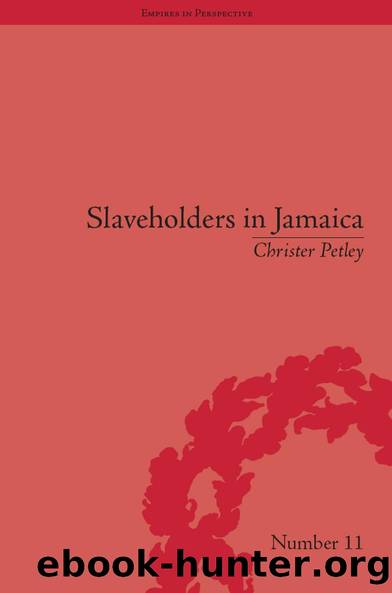Slaveholders in Jamaica by Christer Petley

Author:Christer Petley [Petley, Christer]
Language: eng
Format: epub
Tags: History, General, Social History
ISBN: 9781317313922
Google: Uts5CgAAQBAJ
Publisher: Routledge
Published: 2015-10-06T01:25:59+00:00
7 BACKLASH
During the Jamaican slave uprising, Hamilton Brown was a lieutenant colonel in the St Ann Western Division of the island militia. Serving under Colonel James Hilton, he was posted on 1 January 1832 to Rio Bueno, at the border between the parishes of Trelawny and St Ann. In Hiltonâs view, an uprising of enslaved people in the area was poised to commence and he wrote that a âregular place of insurrection was organized in this neighbourhoodâ. Hilton therefore sent a company of 100 mounted troops under Brown to Harmony Hall and Lancaster estates and reported to his commander-in-chief, Willoughby Cotton, that Brownâs men âspeedily reduced the Insurgents to reasonâ. The next day Brown, who like other slaveholders believed that enslaved people had been compelled to rebel because of âthe bad advice of the Methodists & Baptists Parsonsâ, rode with his men to properties in the district to ensure enslaved people there were at work and to challenge any signs of disaffection. A letter to the St Jago de la Vega Gazette alluded to the terror tactics that were used by such militia companies. The author wrote that âColonel Hilton, immediately on his arrival, caused to be made known in the neighbourhood, and particularly on those properties the slaves of which were disaffected, that he would annihilate the first party that dare to perform the smallest act of rebellionâ.1
Brown worked hard to repress the uprising and was proud of what he did. His ride around the estates in the vicinity of Rio Bueno covered over thirty miles, and his men rode at full charge between properties. Of the eleven estates his detachment went to, he wrote that âwith the exception of Manchester I found the Negroes all at workâ. At Manchester he claimed that the ânegro houses ⦠had 14 of the Ringleadersâ. He arrested these men and took them back to Hilton, who sent them on to the town of Falmouth for trial. As the remaining insurgents retreated, Brown was involved in the hunt for fugitives in St James. His strenuous efforts left him ill, but despite suffering âindisposition from fatigue during the late rebellionâ, he felt his work had been worthwhile, noting that his endeavours had won him praise from Cotton and from Major General Cox of the militia. In March 1832, he wrote of the âCorps that I had the honour to commandâ and described how he and his men âtook up in the woods &c abt 40 Incendiaries & Rebels â several of whom were Drivers & other Head menâ. According to Brown, of these captives, â10 were hanged & 13 sentenced to 300 lashes of the Cat, & the different Work Houses for Lifeâ.2
Hamilton Brownâs words and actions during and immediately after the uprising shed light on the nature of the white backlash that began to gather momentum in the first months of 1832. As abolitionism held sway over metropolitan public opinion and white Jamaican slaveholders faced the aftermath of the uprising, many colonists responded in similar ways to Brown.
Download
This site does not store any files on its server. We only index and link to content provided by other sites. Please contact the content providers to delete copyright contents if any and email us, we'll remove relevant links or contents immediately.
| Africa | Americas |
| Arctic & Antarctica | Asia |
| Australia & Oceania | Europe |
| Middle East | Russia |
| United States | World |
| Ancient Civilizations | Military |
| Historical Study & Educational Resources |
Cat's cradle by Kurt Vonnegut(14763)
Pimp by Iceberg Slim(13781)
Underground: A Human History of the Worlds Beneath Our Feet by Will Hunt(11840)
4 3 2 1: A Novel by Paul Auster(11794)
The Radium Girls by Kate Moore(11624)
Wiseguy by Nicholas Pileggi(5320)
American History Stories, Volume III (Yesterday's Classics) by Pratt Mara L(5138)
Perfect Rhythm by Jae(5074)
The Fire Next Time by James Baldwin(5021)
Paper Towns by Green John(4801)
Pale Blue Dot by Carl Sagan(4620)
A Higher Loyalty: Truth, Lies, and Leadership by James Comey(4554)
The Mayflower and the Pilgrims' New World by Nathaniel Philbrick(4283)
The Doomsday Machine by Daniel Ellsberg(4248)
Killers of the Flower Moon: The Osage Murders and the Birth of the FBI by David Grann(4191)
Too Much and Not the Mood by Durga Chew-Bose(4096)
The Sympathizer by Viet Thanh Nguyen(4096)
The Borden Murders by Sarah Miller(4021)
Sticky Fingers by Joe Hagan(3913)
